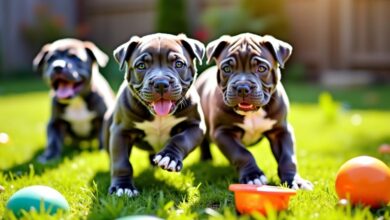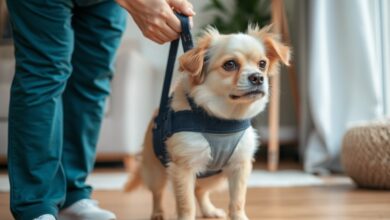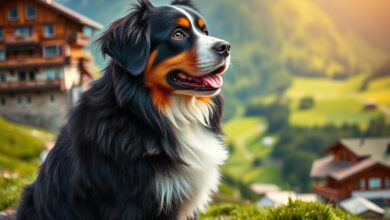Giant Schnauzer Puppies – 9 Facts to Know
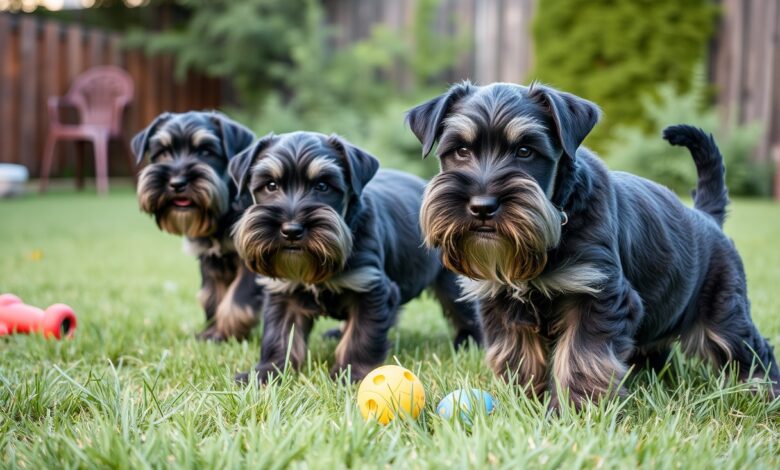
Facts about Giant Schnauzer puppies can be necessary for potential owners like you. These intelligent and energetic dogs require proper training and socialization from an early age. With their strong protective instincts, they can make excellent family pets, but they also need a firm handler to manage their lively temperament. As you consider bringing a Giant Schnauzer into your home, you’ll discover important details about their care, grooming needs, and exercise requirements that will help you foster a healthy, happy environment for your new furry companion.
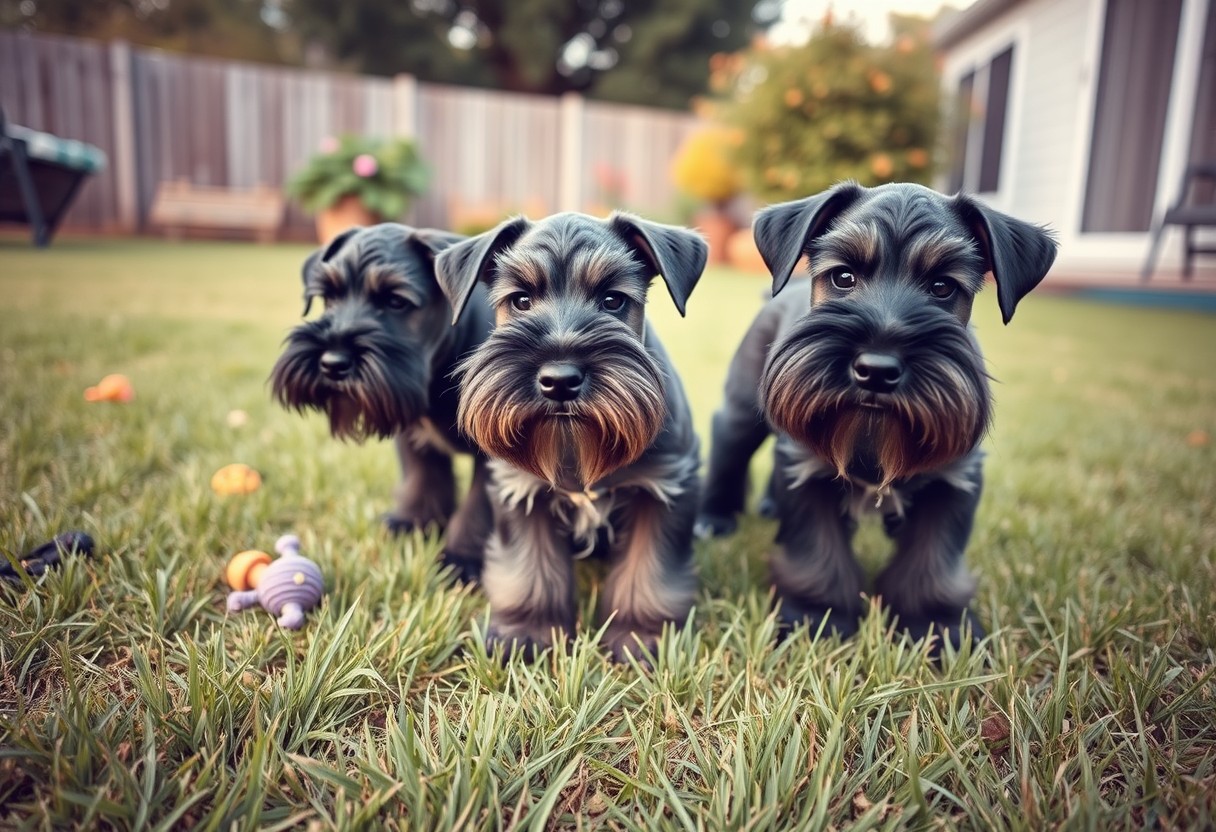
Key Takeaways:
- Temperament: Giant Schnauzers are known for their intelligence and loyalty, making them excellent family pets and protective companions.
- Grooming Needs: Their distinctive coat requires regular grooming to maintain its quality and prevent matting, which is vital for their overall health and appearance.
- Exercise Requirements: These puppies are highly energetic and require consistent exercise to keep them healthy and happy, making them ideal for active owners.
Origin and History
While the Giant Schnauzer may seem like a modern breed, its roots trace back to Germany in the 17th century. Initially bred to drive cattle and guard farms, this impressive dog became a staple in various roles throughout history. As a versatile working dog, the Giant Schnauzer developed a reputation for its strength, intelligence, and loyalty, making it increasingly popular among farmers and the military alike.
Ancestry of the Giant Schnauzer
To understand the Giant Schnauzer’s ancestry, you can look at its lineage, which includes the Standard Schnauzer and various herding breeds. These dogs were selectively bred for their instinctive herding abilities, resilience, and protective nature. Over time, each generation contributed to the giant’s unique physical characteristics and temperament, making them suitable for a range of working tasks.
Historical Significance
Ancestry plays a crucial role in the significance of the Giant Schnauzer. As a highly regarded working dog, these animals participated in various important functions, including police work, military service, and security. Their protective instincts were invaluable during war times, where they were trained to detect intruders and assist in guarding personnel. The Giant Schnauzer’s enduring legacy is a testament to its skill and versatility as a dependable companion.
Historical accounts highlight the Giant Schnauzer’s contributions during challenging periods, especially in military contexts, where they often served as service dogs. Their capabilities in detecting dangers and providing security made them indispensable, showcasing their potential not only as loyal pets but also as courageous protectors. By understanding their historical significance, you can appreciate the breed’s evolution from a working dog to a beloved family member today.
Temperament and Behavior
It is vital to understand the temperament and behavior of Giant Schnauzer puppies as they can vary significantly. Generally, they are known for their bold, spirited nature, and intelligence, making them excellent companions and working dogs. Their loyalty and protective instincts make them great family pets. However, they require consistent training and socialization to ensure they adapt well to various environments and situations.
Personality Traits
One of the most notable personality traits of Giant Schnauzers is their strong sense of loyalty. They bond closely with their families and are naturally protective, often becoming excellent watchdogs. Additionally, they display a sense of affection and playfulness, making them enjoyable companions. However, their intelligence leads to a need for mental stimulation, so interactive play and training are crucial to keeping them engaged.
Socialization Needs
Personality is not just about traits; it also encompasses how well your Giant Schnauzer interacts with the world around them. Proper socialization is crucial for these puppies, as it helps them develop a well-rounded personality and reduces the risk of aggression or anxiety in new situations. By exposing your puppy to a variety of environments, people, and other pets, you can promote positive behavior and enhance their natural instincts.
This early exposure and ongoing socialization play a vital role in ensuring your Giant Schnauzer grows into a confident and well-adjusted adult. A lack of socialization may lead to fearful or defensive behavior, which can manifest in barking or even aggression. Therefore, consistently introducing your puppy to different experiences will help them learn to navigate the world with ease and confidence.
Physical Characteristics
All Giant Schnauzers are known for their impressive and robust physique. They possess a sturdy build with a strong, square outline, making them both powerful and agile. Their well-defined muscles and strong bones contribute to their overall athleticism. Another striking feature is their bushy eyebrows and beard, which lend them a dignified expression. With their alert and confident demeanor, these dogs exude a commanding presence that is hard to overlook.
Size and Weight
For Giant Schnauzer puppies, you can expect them to grow into large, muscular dogs, typically weighing between 55 to 85 pounds and standing 23 to 28 inches tall at the shoulder. It’s necessary to monitor their growth and ensure they reach their full potential size at a healthy rate.
Coat and Grooming Requirements
For the Giant Schnauzer’s coat, you will find it to be dense, wiry, and weather-resistant. Regular grooming is crucial to keep their coat healthy and to prevent matting. This breed requires brushing several times a week and professional grooming every few months to maintain a polished appearance.
Requirements for grooming your Giant Schnauzer are significant, as their double coat tends to shed and mat if not properly cared for. You should invest in high-quality grooming tools such as a slicker brush and shedding blade. Regularly trim the hair around their eyes and paws to keep them tidy. It’s also necessary to ensure their ears are clean and check that their teeth are brushed at least a few times a week. Skipping these grooming tasks can lead to skin problems and discomfort for your dog, so staying consistent is key to a happy and healthy Giant Schnauzer.
Health Considerations
Once again, it’s important to understand the health considerations associated with owning a Giant Schnauzer puppy. This breed is generally robust, but like all dogs, they can be prone to certain health issues. Regular check-ups and awareness of any emerging health concerns will help ensure your puppy grows into a healthy adult, allowing you to fully enjoy the companionship of this magnificent breed.
Common Health Issues
To keep your Giant Schnauzer healthy, be aware of the common health issues they may face. This breed can be prone to conditions such as hip and elbow dysplasia, progressive retinal atrophy, and certain types of cancer. By educating yourself on these risks, you can take proactive measures to manage your puppy’s health effectively.
Preventative Care
The best way to safeguard your Giant Schnauzer’s health is through effective preventative care. This includes regular veterinary check-ups, vaccinations, a balanced diet, and a consistent exercise routine. By staying vigilant, you can catch potential health problems early and ensure your puppy thrives.
Plus, it’s important to familiarize yourself with dietary needs, ensuring you provide high-quality food specifically formulated for large breeds. Incorporate routine exercise to support healthy weight management and joint development. Don’t forget the significance of socialization and training, which promote mental well-being and prevent behavioral issues. A proactive approach to preventative care not only enhances your dog’s quality of life but also strengthens the bond you share.
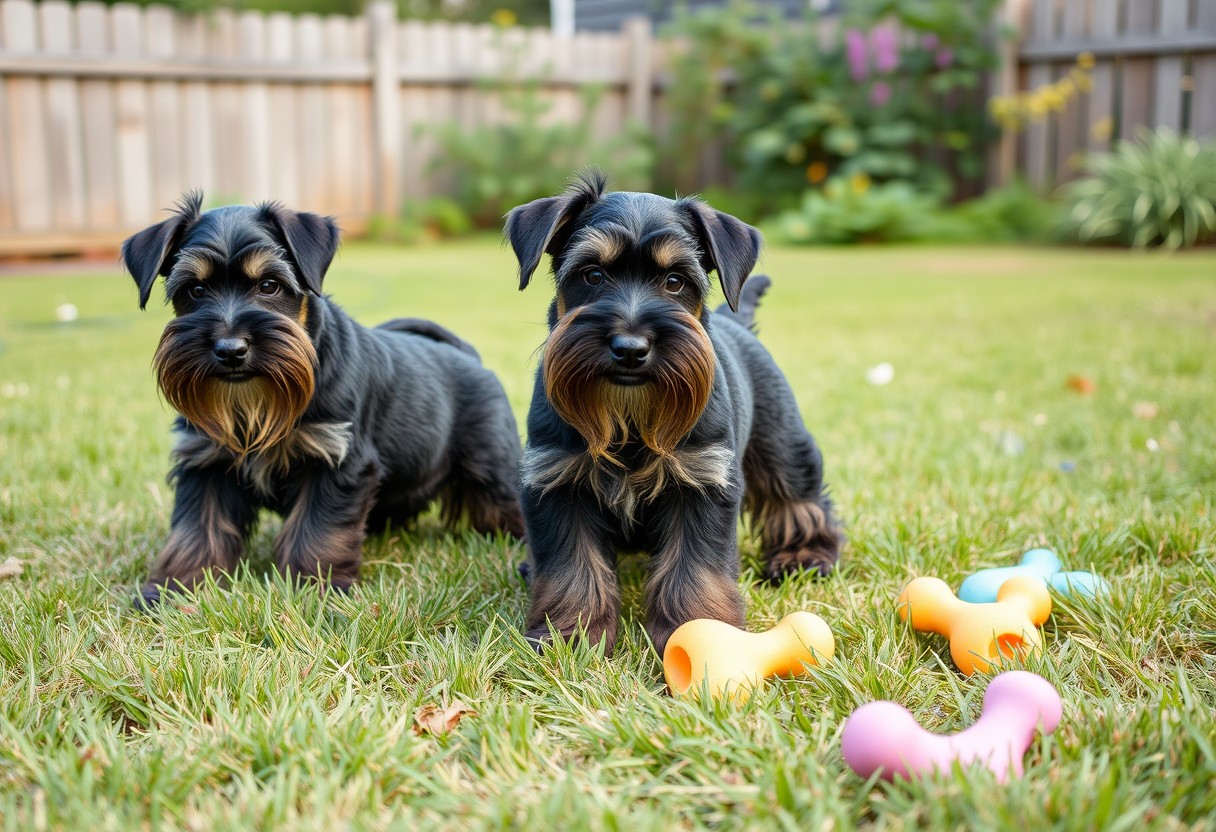
Training and Obedience
Many people find training their Giant Schnauzer puppies to be a rewarding and imperative part of puppy ownership. These intelligent and energetic dogs thrive on mental challenges and require consistent, positive reinforcement to learn commands and proper behavior. With your guidance, they can become well-behaved companions while forming a strong bond with you during the training process.
Training Methods
For successful training of your Giant Schnauzer puppy, consider using positive reinforcement techniques. Reward your pup with treats, praise, or playtime for good behavior, reinforcing desired actions. Consistency is key, so establish a routine and be patient as your puppy learns. Avoid harsh corrections, as they can lead to fear and anxiety, which hinders their ability to learn.
Early Socialization
For your Giant Schnauzer puppy’s development, early socialization is crucial. Introducing your pup to various environments, people, and other animals helps them become well-adjusted and confident adults. Aim for a mix of positive experiences to reduce the risk of fearfulness and aggression later in life.
Another important aspect of early socialization is exposure to different sounds, smells, and situations. Take your puppy on walks in busy areas, invite friends over, and expose them to other pets. The more experiences they have in their early months, the better prepared they will be to handle new challenges as they grow. A well-socialized Giant Schnauzer will be more adaptable, confident, and a joy to have around, ensuring they are an active and engaged member of your family.
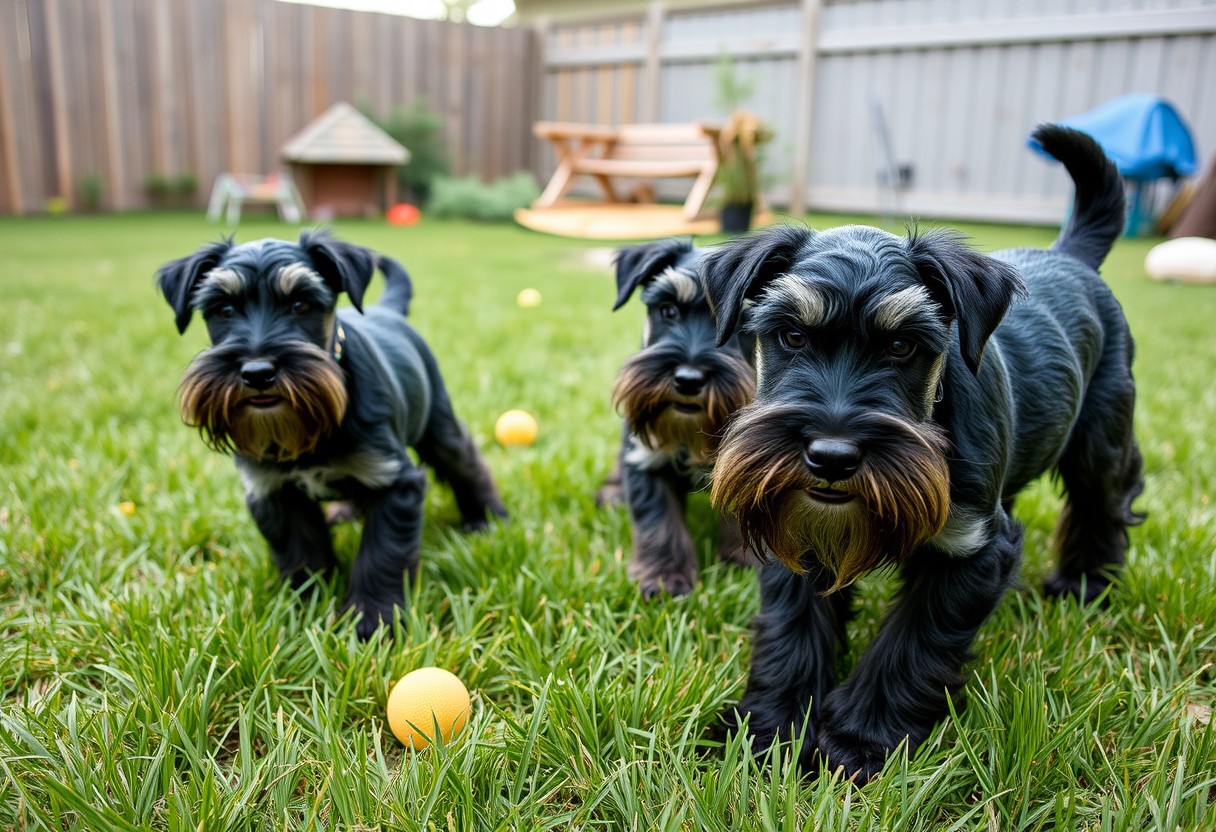
Exercise and Activity Needs
After bringing a Giant Schnauzer puppy into your home, it’s crucial to understand their significant exercise and activity needs. These intelligent and energetic dogs thrive on physical activity and mental challenges, requiring more than just a casual stroll. Aim for at least an hour of structured exercise each day to keep your puppy healthy, happy, and well-behaved. Consistent activity will not only help in building their strength but also curb destructive behaviors that may arise from boredom.
Recommended Exercise Routines
One effective way to meet your Giant Schnauzer’s exercise needs is to establish a daily routine that includes a mix of outdoor walks, playtime, and structured activities. Incorporate at least two brisk walks each day alongside play sessions with toys that encourage running and fetching. Engaging in activities like agility training or obedience classes can also provide crucial physical exercise and mental stimulation that your puppy craves.
Mental Stimulation Activities
An crucial aspect of your Giant Schnauzer puppy’s well-being is mental stimulation. This breed is known for its intelligence, and without adequate challenges, they can become bored and develop undesirable behaviors. Engaging your puppy in puzzle toys, interactive games, or scent work can keep their minds sharp. Teaching them new commands and tricks not only provides mental exercise but also strengthens the bond between you and your puppy.
A variety of mental stimulation activities is important for your Giant Schnauzer puppy’s development. Consider introducing puzzle toys that challenge them to solve problems to receive a treat; these toys promote cognitive skills and keep them entertained. Regularly rotating toys can also help to maintain their interest. Additionally, engaging in hide-and-seek games, scent trails, or teaching them simple commands can keep their minds active and prevent boredom. Recall, a well-stimulated Giant Schnauzer is a happy and well-adjusted pet!
To wrap up
To wrap up, understanding these 9 crucial facts about Giant Schnauzer puppies will help you make an informed decision and prepare for your new furry companion. From their exercise needs to grooming requirements, being well-equipped with knowledge will ensure a harmonious life with this intelligent breed. Be mindful of, investing in their health and care is crucial for a long and happy journey together. For more insights, you can explore the Giant Schnauzer Dog Breed Health and Care resource.
FAQ
Q: What are the key characteristics of Giant Schnauzer puppies?
A: Giant Schnauzer puppies are known for their intelligence, loyalty, and protective instincts. They are a large breed, typically weighing between 55 to 85 pounds when fully grown. Their distinctive, wiry coat requires regular grooming to maintain its health. These puppies are highly energetic and require ample exercise and mental stimulation to keep them happy. Socialization is crucial at a young age to help them develop into well-rounded adult dogs. Additionally, they are known for being good with families, especially when raised with children.
Q: How should I train my Giant Schnauzer puppy?
A: Training a Giant Schnauzer puppy should start as early as possible due to their intelligence and eagerness to learn. Consistency and positive reinforcement techniques, such as treats and praise, work best. It’s important to establish boundaries and commands clearly, and using firm yet gentle methods will yield the best results. Given their protective nature, early socialization with other dogs, people, and various environments is necessary to prevent aggressive tendencies. Obedience classes can be a great way to train and socialize your puppy at the same time.
Q: What health concerns should I be aware of for Giant Schnauzer puppies?
A: Giant Schnauzer puppies can be prone to certain health issues, including hip dysplasia, elbow dysplasia, and certain eye conditions such as cataracts. Regular vet check-ups and vaccinations are crucial during their early development stages. To ensure the best health for your puppy, maintain a balanced diet and provide them with regular exercise. Genetic testing of breeding parents can also help reduce the risk of inherited health problems. It’s advisable to choose a reputable breeder who conducts health screenings for their breeding stock.


